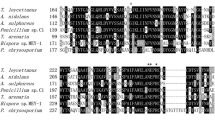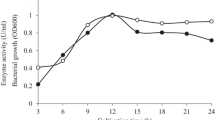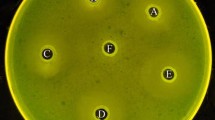Abstract
A mannanase-coding gene was cloned from Sphingobacterium sp. GN25 isolated from the feces of Grus nigricollis. The gene encodes a 371-residue polypeptide (ManAGN25) showing less than 74 % identity with a number of hypothetical proteins and putative glucanases and mannanases. Before experiment’s performance, ManAGN25 was predicted to be a low-temperature active mannanase based on the molecular characterization, including (1) ManAGN25 shared the highest identity of 41.1 % with the experimentally verified low-temperature active mannanase (ManAJB13) from Sphingomonas sp. JB13; (2) compared with their mesophilic and thermophilic counterparts, ManAGN25 and ManAJB13 had increased number of amino acid residues around their catalytic sites; (3) these increased number of amino acid residues built longer loops, more α-helices, and larger total accessible surface area and packing volume. Then the experiments of biochemical characterization verified that the purified recombinant ManAGN25 is a low-temperature active mannanase: the enzyme showed apparently optimal activity at 35–40 °C and retained 78.2, 44.8, and 15.0 % of its maximum activity when assayed at 30, 20, and 10 °C, respectively; the half-life of the enzyme was approximately 60 min at 37 °C; the enzyme presented a K m of 4.2 mg/ml and a k cat of 0.4/s in McIlvaine buffer (pH 7.0) at 35 °C using locust bean gum as the substrate; and the activation energy for hydrolysis of locust bean gum by the enzyme was 36.0 kJ/mol. This study is the first to report the molecular and biochemical characterizations of a mannanase from a strain.





Similar content being viewed by others
Abbreviations
- manAGN25 :
-
Mannanase-coding gene from Sphingobacterium sp. GN25
- ManAGN25:
-
Mannanase from Sphingobacterium sp. GN25
- rManAGN25:
-
Recombinant ManAGN25
- ManAJB13:
-
The low-temperature active mannanase from Sphingomonas sp. JB13
- ManA:
-
Thermophilic mannanase from Dictyoglomus thermophilum Rt46B.1
- Man26BCD:
-
Mesophilic mannanase from Paenibacillus sp. BME-14
- PMAN:
-
Low-temperature active mannanase from Glaciozyma antarctica PI12
- G. nigricollis :
-
Grus nigricollis
- E. coli :
-
Escherichia coli
- S. thalpophilum :
-
Sphingobacterium thalpophilum
- GH:
-
Glycosyl hydrolase family
- IUCN:
-
International Union for Conservation of Nature
- PCR:
-
Degenerate polymerase chain reaction
- TAIL-PCR:
-
Thermal asymmetric interlaced PCR
- IPTG:
-
Isopropyl-β-d-1-thiogalactopyranoside
- SP primers:
-
Nested insertion-specific primers
- ASA:
-
Accessible surface area
- TPV:
-
Total packing volume
- pET-manAGN25 :
-
Recombinant plasmid of pET-28a(+) vector and coding sequence of the mature protein of manAGN25
- LB:
-
Luria–Bertani
- Buffer A:
-
20 mmol/l Tris–HCl 0.5 mol/l NaCl, pH 7.2
- SDS-PAGE:
-
Sodium dodecyl sulfate-polyacrylamide gel electrophoresis
- MALDI-TOF MS:
-
Matrix-assisted laser desorption/ionization time-of-flight mass spectrometry
- DNS:
-
3,5-Dinitrosalicylic acid
- U:
-
Unit
- McIlvaine buffer:
-
A mixture of 0.1 mol/l citric acid and 0.2 mol/l Na2HPO4
- P1–P4:
- T m :
-
Annealing temperature
- NR:
-
Not reported
- Ea:
-
Activation energy
- ΔG * :
-
Free energy of activation
- ΔH * :
-
Enthalpy of activation
- ΔS * :
-
Entropy of activation
- Q10 :
-
Temperature coefficient
References
Bradford MM (1976) A rapid and sensitive method for the quantitation of microgram quantities of protein utilizing the principle of protein-dye binding. Anal Biochem 72(1–2):248–254. doi:10.1016/0003-2697(76)90527-3
Brulc JM, Antonopoulos DA, Miller MEB, Wilson MK, Yannarell AC, Dinsdale EA, Edwards RE, Frank ED, Emerson JB, Wacklin P, Coutinho PM, Henrissat B, Nelson KE, White BA (2009) Gene-centric metagenomics of the fiber-adherent bovine rumen microbiome reveals forage specific glycoside hydrolases. Proc Natl Acad Sci U S A 106(6):1948–1953. doi:10.1073/pnas.0806191105
Cavicchioli R, Charlton T, Ertan H, Omar SM, Siddiqui KS, Williams TJ (2011) Biotechnological uses of enzymes from psychrophiles. Microb Biotechnol 4(4):449–460. doi:10.1111/j.1751-7915.2011.00258.x
Chauhan PS, Puri N, Sharma P, Gupta N (2012) Mannanases: microbial sources, production, properties and potential biotechnological applications. Appl Microbiol Biotechnol 93(5):1817–1830. doi:10.1007/s00253-012-3887-5
Dhawan S, Kaur J (2007) Microbial mannanases: an overview of production and applications. Crit Rev Biotechnol 27(4):197–216. doi:10.1080/07388550701775919
Feller G, Gerday C (2003) Psychrophilic enzymes: hot topics in cold adaptation. Nat Rev Microbiol 1(3):200–208. doi:10.1038/nrmicro773
Fu X, Huang X, Liu P, Lin L, Wu G, Li C, Feng C, Hong Y (2010) Cloning and characterization of a novel mannanase from Paenibacillus sp. BME-14. J Microbiol Biotechnol 20(3):518–524. doi:10.4014/jmb.0906.06027
Ghosh A, Luis AS, Bras JLA, Fontes C, Goyal A (2013) Thermostable recombinant β-(1→4)-mannanase from C. thermocellum: biochemical characterization and manno-oligosaccharides production. J Agric Food Chem 61(50):12333–12344. doi:10.1021/jf403111g
Gibbs MD, Reeves RA, Sunna A, Bergquist PL (1999) Sequencing and expression of a β-mannanase gene from the extreme thermophile Dictyoglomus thermophilum Rt46B.1, and characteristics of the recombinant enzyme. Curr Microbiol 39(6):351–357. doi:10.1007/s002849900471
Hogg D, Woo EJ, Bolam DN, McKie VA, Gilbert HJ, Pickersgill RW (2001) Crystal structure of mannanase 26A from Pseudomonas cellulosa and analysis of residues involved in substrate binding. J Biol Chem 276(33):31186–31192. doi:10.1074/jbc.M010290200
Huang JL, Bao LX, Zou HY, Che SG, Wang GX (2012) High-level production of a cold active β-mannanase from Bacillus subtilis Bs5 and its molecular cloning and expression. Mol Genet Microbiol 27(4):147–153. doi:10.3103/s0891416812040039
Humphrey W, Dalke A, Schulten K (1996) VMD: visual molecular dynamics. J Mol Graph 14(1):33–38
Kanjanavas P, Khawsak P, Pakpitcharoen A, Areekit S, Sriyaphai T, Pothivejkul K, Santiwatanakul S, Matsui K, Kajiwara T, Chansiri K (2009) Over-expression and characterization of the alkalophilic, organic solvent-tolerant, and thermotolerant endo-1,4-β-mannanase from Bacillus licheniformis isolate THCM 3.1. Sci Asia 35(1):17–23. doi:10.2306/scienceasia1513-1874.2009.35.017
Katrolia P, Zhou P, Zhang P, Yan QJ, Li YN, Jiang ZQ, Xu HB (2012) High level expression of a novel β-mannanase from Chaetomium sp. exhibiting efficient mannan hydrolysis. Carbohydr Polym 87(1):480–490. doi:10.1016/j.carbpol.2011.08.008
Katrolia P, Yan QJ, Zhang P, Zhou P, Yang SQ, Jiang ZQ (2013) Gene cloning and enzymatic characterization of an alkali-tolerant endo-1,4-β-mannanase from Rhizomucor miehei. J Agric Food Chem 61(2):394–401. doi:10.1021/jf303319h
Kim DY, Ham SJ, Lee HJ, Kim YJ, Shin DH, Rhee YH, Son KH, Park HY (2011) A highly active endo-β-1,4-mannanase produced by Cellulosimicrobium sp. strain HY-13, a hemicellulolytic bacterium in the gut of Eisenia fetida. Enzyme Microb Technol 48(4-5):365–370. doi:10.1016/j.enzmictec.2010.12.013
Kokkinidis M, Glykos NM, Fadouloglou VE (2012) Protein flexibility and enzymatic catalysis. Adv Protein Chem Struct 87:181–218. doi:10.1016/b978-0-12-398312-1.00007-x
Kong DJ, Yang XJ, Liu Q, Zhong XY, Yang JX (2011) Winter habitat selection by the vulnerable black-necked crane Grus nigricollis in Yunnan, China: implications for determining effective conservation actions. Oryx 45(2):258–264. doi:10.1017/s0030605310000888
Ley RE, Hamady M, Lozupone C, Turnbaugh PJ, Ramey RR, Bircher JS, Schlegel ML, Tucker TA, Schrenzel MD, Knight R, Gordon JI (2008) Evolution of mammals and their gut microbes. Science 320(5883):1647–1651. doi:10.1126/science.1155725
Lu HQ, Zhang HT, Shi PJ, Luo HY, Wang YR, Yang PL, Yao B (2013) A family 5 β-mannanase from the thermophilic fungus Thielavia arenaria XZ7 with typical thermophilic enzyme features. Appl Microbiol Biot 97(18):8121–8128. doi:10.1007/s00253-012-4656-1
Lu HQ, Luo HY, Shi PJ, Huang HQ, Meng K, Yang PL, Yao B (2014) A novel thermophilic endo-β-1,4-mannanase from Aspergillus nidulans XZ3: functional roles of carbohydrate-binding module and Thr/Ser-rich linker region. Appl Microbiol Biotechnol 98(5):2155–2163. doi:10.1007/s00253-013-5112-6
Luo HY, Wang K, Huang HQ, Shi PJ, Yang PL, Yao B (2012) Gene cloning, expression, and biochemical characterization of an alkali-tolerant β-mannanase from Humicola insolens Y1. J Ind Microbiol Biotechnol 39(4):547–555. doi:10.1007/s10295-011-1067-8
Parvizpour S, Razmara J, Ramli ANM, Illias RM, Shamsir MS (2014) Structural and functional analysis of a novel psychrophilic β-mannanase from Glaciozyma antarctica PI12. J Comput Aided Mol Des 28(6):685–698. doi:10.1007/s10822-014-9751-1
Pettersen EF, Goddard TD, Huang CC, Couch GS, Greenblatt DM, Meng EC, Ferrin TE (2004) UCSF chimera—a visualization system for exploratory research and analysis. J Comput Chem 25(13):1605–1612. doi:10.1002/jcc.20084
Politz O, Krah M, Thomsen KK, Borriss R (2000) A highly thermostable endo-(1,4)-β-mannanase from the marine bacterium Rhodothermus marinus. Appl Microbiol Biotechnol 53(6):715–721
Rodrigues DF, Tiedje JM (2008) Coping with our cold planet. Appl Environ Microbiol 74(6):1677–1686. doi:10.1128/aem.02000-07
Siddiqui KS, Cavicchioli R (2006) Cold-adapted enzymes. Annu Rev Biochem 75(1):403–433. doi:10.1146/annurev.biochem.75.103004.142723
Siddiqui KS, Cavicchioli R, Thomas T (2002) Thermodynamic activation properties of elongation factor 2 (EF-2) proteins from psychrotolerant and thermophilic Archaea. Extremophiles 6(2):143–150. doi:10.1007/s007920100237
Songsiriritthigul C, Buranabanyat B, Haltrich D, Yamabhai M (2010) Efficient recombinant expression and secretion of a thermostable GH26 mannan endo-1,4-β-mannosidase from Bacillus licheniformis in Escherichia coli. Microb Cell Fact 9:20. doi:10.1186/1475-2859-9-20
Srivastava P, Appu Rao AR, Kapoor M (2014) Structural insights into the thermal stability of endo-mannanase belonging to family 26 from Bacillus sp. CFR1601. FASEB J 28(Supplement 1):580.2
Summpunn P, Chaijan S, Isarangkul D, Wiyakrutta S, Meevootisom V (2011) Characterization, gene cloning, and heterologous expression of β-mannanase from a thermophilic Bacillus subtilis. J Microbiol 49(1):86–93. doi:10.1007/s12275-011-0357-1
Wang G, Luo H, Wang Y, Huang H, Shi P, Yang P, Meng K, Bai Y, Yao B (2011) A novel cold-active xylanase gene from the environmental DNA of goat rumen contents: direct cloning, expression and enzyme characterization. Bioresour Technol 102(3):3330–3336. doi:10.1016/j.biortech.2010.11.004
Warnecke F, Luginbuhl P, Ivanova N, Ghassemian M, Richardson TH, Stege JT, Cayouette M, McHardy AC, Djordjevic G, Aboushadi N, Sorek R, Tringe SG, Podar M, Martin HG, Kunin V, Dalevi D, Madejska J, Kirton E, Platt D, Szeto E, Salamov A, Barry K, Mikhailova N, Kyrpides NC, Matson EG, Ottesen EA, Zhang XN, Hernandez M, Murillo C, Acosta LG, Rigoutsos I, Tamayo G, Green BD, Chang C, Rubin EM, Mathur EJ, Robertson DE, Hugenholtz P, Leadbetter JR (2007) Metagenomic and functional analysis of hindgut microbiota of a wood-feeding higher termite. Nature 450(7169):560–565. doi:10.1038/nature06269
Willard L, Ranjan A, Zhang HY, Monzavi H, Boyko RF, Sykes BD, Wishart DS (2003) VADAR: a web server for quantitative evaluation of protein structure quality. Nucleic Acids Res 31(13):3316–3319. doi:10.1093/nar/gkg565
Yamabhai M, Sak-Ubol S, Srila W, Haltrich D (2014) Mannan biotechnology: from biofuels to health. Crit Rev Biotechnol: 1–11. doi: 10.3109/07388551.2014.923372
Zhou JP, Huang HQ, Meng K, Shi PJ, Wang YR, Luo HY, Yang PL, Bai YG, Yao B (2010) Cloning of a new xylanase gene from Streptomyces sp. TN119 using a modified thermal asymmetric interlaced-PCR specific for GC-rich genes and biochemical characterization. Appl Biochem Biotechnol 160(5):1277–1292. doi:10.1007/s12010-009-8642-8
Zhou JP, Zhang R, Gao YJ, Li JJ, Tang XH, Mu YL, Wang F, Li C, Dong YY, Huang ZX (2012) Novel low-temperature-active, salt-tolerant and proteases-resistant endo-1,4-β-mannanase from a new Sphingomonas strain. J Biosci Bioeng 113(5):568–574. doi:10.1016/j.jbiosc.2011.12.011
Zhou JP, Gao YJ, Zhang R, Mo MH, Tang XH, Li JJ, Xu B, Ding JM, Huang ZX (2014) A novel low-temperature-active exo-inulinase identified based on molecular-activity strategy from Sphingobacterium sp. GN25 isolated from feces of Grus nigricollis. Process Biochem 49(10):1656–1663. doi:10.1016/j.procbio.2014.06.013
Acknowledgments
This work was supported by the Key Technologies Research and Development Program of China (2013BAD10B01), the National Natural Science Foundation of China (31460694), and the Applied and Basic Research Foundation of Yunnan Province (2011FB048 and 2013FZ045).
Conflict of interest
None
Author information
Authors and Affiliations
Corresponding author
Additional information
Rui Zhang and Junpei Zhou contributed equally to this work.
Rights and permissions
About this article
Cite this article
Zhang, R., Zhou, J., Gao, Y. et al. Molecular and biochemical characterizations of a new low-temperature active mannanase. Folia Microbiol 60, 483–492 (2015). https://doi.org/10.1007/s12223-015-0391-1
Received:
Accepted:
Published:
Issue Date:
DOI: https://doi.org/10.1007/s12223-015-0391-1




